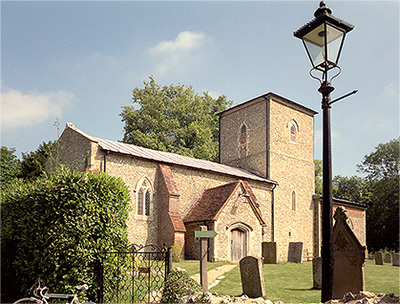Microscopy
puzzle in an English church
by David Walker, UK
Right: St. Mary's Church, Radnage, Buckinghamshire, UK.

|
Microscopy
puzzle in an English church by David Walker, UK
Right: St. Mary's Church, Radnage, Buckinghamshire, UK. |
|
When I use to live in an outer suburb of west London, I greatly enjoyed exploring the local countryside on a bicycle at weekends. Not too far from London there are many quiet delightful lanes and villages to explore. The Chiltern hills are a particularly beautiful area and I stopped on one cycle journey on a sunny Saturday in the village of Radnage, Buckinghamshire. One particular appeal of English villages is the parish church and they are invariably open to explore and reveal unique aspects of each village, its history and the local characters. (As well as offering to the cyclist or walker a cool place to rest and reflect on a hot summer's day or shelter on a cold and wet wintry day). The parish church in Radnage is St. Mary's and the image above shows the view from the churchyard gate and the view down the nave towards the chancel is shown right. A short history of the very old church can be found on the www.radnage.net website which also gives maps and details on how to visit the village of Radnage. |
|
|
It was an attractive and peaceful church to browse around, but as a microscopy enthusiast, the church tour revealed a very unexpected bonus. The stained glass window in the north chancel featured a stylised microscope and was dedicated to the Reverend Benjamin John Corder. The window is shown below together with information written in neat calligraphy on the dedicated window in a frame. The valuable online database of Buckinghamshire stained glass has an entry for this window (thank you to the webmasters for this resource who were also helpful in my queries on the window and designer).
The detail of the microscope is shown above. The dedication and mention of the Reverend's microscopy related work piqued my interest. The Rev. Nigel Lacey of St Mary's very kindly provided a short biography of the Rev. Corder by email and he was clearly a man of many talents in widely differing fields. Details of the Rev. Corder's microscopy related work is uncertain and if any reader can provide any further information on the Rev. Corder and his work I'd be very interested to hear from them. It also made me wonder if this window is unique; are there any other stained glass windows in the UK or elsewhere that feature a microscope, if anybody knows of one I'd be interested to learn about it. Or perhaps widen the query to other artwork such as sculptures that feature a microscope. Comments to the author David Walker are welcomed. Thank you to the Rev. Nigel Lacey for permission to share interior views of the church. (Photographs by the author taken on an ageing but useful Olympus 35RC and negatives scanned. Perspective errors from photographing upwards corrected in Photoshop Elements.) |
Please report any Web problems or offer general comments to the Micscape Editor .
Micscape is the on-line monthly magazine of the Microscopy UK web site at Microscopy-UK